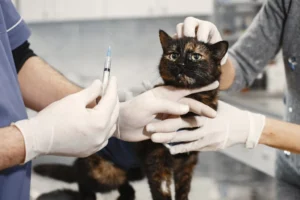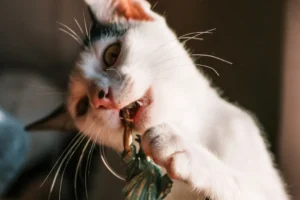Have you ever noticed that your cat seems to bolt as soon as you lean in for a kiss? It can be frustrating and leave you wondering why your furry friend is so averse to your affection. But fear not, we’re here to shed some light on this common feline behavior.
The reason why your cat runs away when you kiss her is simple: cats are not big fans of face-to-face contact. They are independent creatures who value their personal space, and being suddenly smothered with kisses can feel overwhelming and invasive to them. It’s important to remember that cats show affection in different ways than humans, and forcing physical contact on them can cause stress and anxiety.
Can cats feel suffocated by kisses?
Have you ever noticed your cat running away when you try to shower them with kisses? While you may have the best intentions, cats are unique creatures with their own ways of showing affection. It’s essential to understand that cats can feel overwhelmed and suffocated by excessive kisses and close face-to-face contact. Cats value their personal space and independence, so when you lean in for a smooch, they might interpret it as a threat to their autonomy.
To prevent your feline friend from feeling suffocated, try to respect their boundaries and pay attention to their body language. If your cat starts to tense up, flatten their ears, or exhibit other signs of distress, it’s best to give them some space. Instead of forcing kisses upon them, look for alternative ways to bond with your cat, such as gentle petting, playing with interactive toys, or simply spending quality time together in a relaxed environment.
Remember, every cat is different, so take the time to observe your cat’s reactions and adjust your behavior accordingly. By showing respect for your cat’s boundaries and preferences, you can strengthen your bond and create a more trusting and harmonious relationship with your furry companion.
How do cats show affection?
When it comes to displaying their affection, cats have unique ways of expressing love towards their owners. While some cats may enjoy cuddling and snuggling, others may prefer more subtle signs of affection. It’s essential to understand your cat’s individual preferences and communication style to foster a deeper connection with them.
Some common ways that cats show affection include rubbing against you, kneading with their paws, purring contentedly, or bringing you “gifts” such as toys or prey. These behaviors may seem strange to us, but they are cats’ way of expressing love and trust towards their beloved humans. Cats are masters of subtle communication, so it’s essential to pay attention to these signals to strengthen your bond with your feline friend.
Additionally, creating a safe and welcoming environment for your cat can help them feel secure and loved. Providing plenty of enrichment, including toys, scratching posts, and cozy hiding spots, can enhance your cat’s quality of life and strengthen your relationship. By respecting your cat’s unique way of showing affection and meeting their environmental needs, you can build a strong and loving bond that will last a lifetime.
Are there alternative ways to show affection to my cat?
If your cat isn’t a fan of kisses, there are plenty of other ways to show affection. Gentle petting is often well-received by cats, especially behind the ears or under the chin. Interactive play with toys like feather wands or laser pointers can also be a fun way to bond with your feline friend. Treats are another great way to show love – just make sure not to overdo it! Providing a safe and cozy environment with plenty of hiding spots and vertical space can also help your cat feel secure and loved. Remember, every cat is unique, so experiment with different forms of affection to see what your furry companion enjoys most.
How can I better understand my cat’s boundaries?
Understanding your cat’s boundaries is crucial for building a strong and trusting relationship. Pay attention to your cat’s body language – flattened ears, dilated pupils, or a twitching tail can all indicate discomfort or stress. Respect your cat’s personal space and avoid forcing physical contact if your cat seems hesitant or tries to escape. Offer choices by letting your cat approach you for affection rather than initiating it yourself. Create a safe retreat where your cat can go to relax and unwind when they need space. By respecting your cat’s boundaries and cues, you’ll build a deeper bond based on trust and mutual respect.
- Set up designated scratching posts and perches: Cats love to scratch and climb, so providing appropriate outlets for these behaviors can help your cat feel more comfortable and secure in your home.
- Use pheromone diffusers: Products like Feliway can help reduce stress and anxiety in cats, leading to a more relaxed and trusting relationship between you and your furry friend.
- Consult with a veterinarian or animal behaviorist: If you’re struggling to understand your cat’s behavior or boundaries, seeking professional guidance can provide valuable insights and support.
Is it possible to train a cat to enjoy kisses?
Training a cat to enjoy kisses may be challenging, as not all felines are naturally inclined to this type of affection. However, you can work on building positive associations with kisses by offering treats or favorite toys immediately after a kiss. This helps your cat associate kisses with rewards, increasing the likelihood of them becoming more comfortable over time. Additionally, pay attention to your cat’s body language – if they show signs of stress or discomfort, such as ears flattened back or a twitching tail, give them space and try again later. Remember, every cat is unique, so be patient and respect their boundaries.
Are there any signs I should look for to know if my cat is uncomfortable with kisses?
When it comes to determining if your cat is uncomfortable with kisses, it’s essential to pay attention to their body language. Signs that your cat may not enjoy kisses include flattened ears, dilated pupils, a twitching tail, or pulling away when you lean in for a kiss. If you notice these cues, it’s crucial to respect your cat’s boundaries and avoid forcing them into a situation that causes stress. Instead, focus on building trust and positive associations through gentle interactions and respect for their personal space.
Signs Your Cat May Be Uncomfortable with Kisses:
- Flattened ears or tail twitching
- Dilated pupils
- Pulling away from kisses
- Vocalizing or hissing during close contact
Remember, understanding your cat’s cues and respecting their preferences is key to maintaining a strong and trusting bond with your feline friend.
What are some other ways to bond with my cat?
Building a strong bond with your cat goes beyond just kissing them. One alternative bonding activity is grooming your cat regularly. Cats enjoy being groomed, which can help strengthen your relationship and keep them looking their best. Another great way to bond with your feline friend is to play with them regularly. Interactive toys like feather wands or laser pointers can stimulate your cat’s natural hunting instincts and create a fun way for you to bond with them. Additionally, spending quality time with your cat by simply sitting next to them while they lounge or nap can also help build a strong connection. By engaging in these alternative bonding activities, you can deepen the bond you share with your cat and show them love in a way that they appreciate.
Other ways to bond with your cat:
- Creating a cozy space: Providing a comfortable and safe space for your cat can help them feel secure and deepen your bond.
- Training together: Teaching your cat new tricks or behaviors through positive reinforcement can strengthen your bond and provide mental stimulation for your furry friend.
- Sharing quiet moments: Simply sitting quietly with your cat and offering gentle pets can be a relaxing way to bond and show your love.
- Exploring the outdoors: If your cat enjoys the outdoors, taking them for a supervised walk or providing a safe outdoor enclosure can be a great bonding experience.
By exploring these alternative ways to bond with your cat, you can create a strong and lasting connection based on mutual trust and affection.
Alex, a passionate animal lover, has experience in training and understanding animal behavior. As a proud pet parent to two dogs and three cats, he founded AnimalReport.net to share insights from animal experts and expand his knowledge of the animal kingdom.









